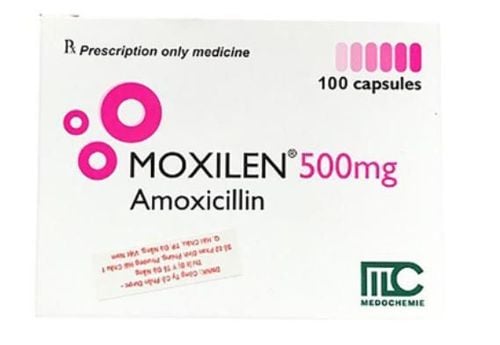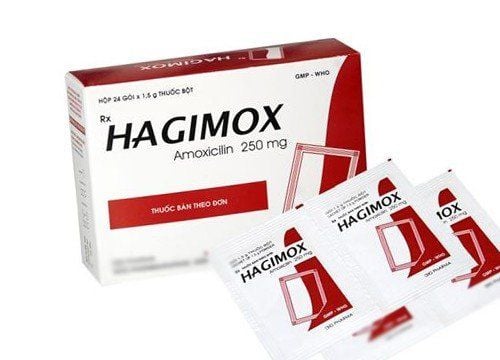This is an automatically translated article.
Ibaxacin 1g is an antibiotic used to treat certain bacterial infections. Please refer to the article below for more useful information about this drug.
1. What is Ibaxacin?
Ibaxacin has the main ingredient Amoxicillin (in the form of Amoxicillin trihydrate) 1g. The drug is indicated for use in the following cases:
Treatment of upper respiratory tract infections Treatment of lower respiratory tract infections caused by pneumococcus, streptococcus and staphylococcus that do not secrete penicillinase and H influenzae. Support treatment of gonorrhea Treatment of urinary tract infections without complications. Biliary tract infections Skin infections caused by streptococcus, staphylococcus, E. coli sensitive to amoxicillin. Treatment of other infections including acute otitis media, strep throat, Salmonella infections, pneumonia, urinary tract infections, Lyme disease and chlamydia infections.
2. Dosage and how to use Ibaxacin 1g
The drug is taken orally. The absorption of amoxicillin into the body is not affected by the amount of food in the stomach, so the patient can take the drug after or before a meal.
The usual applied dose is 250 - 500 mg, every 8 hours to use the drug. Dosage for patients with normal kidney function:
The usual dose for mild and moderate infections is 1g - 2g/day. In the treatment of periodontal abscess, use a dose of 3g, followed by an 8-hour cycle. In the treatment of uncomplicated acute urinary tract infections, use a dose of 3g orally again after 10-12 hours. In the prevention of endocarditis in at-risk patients, a single dose of 3 g should be given 1 hour before procedures such as tooth extraction. Use a high-dose regimen of 3g amoxicillin twice a day for patients with severe respiratory infections or recurrent disease. For patients with renal impairment, the dose of the drug must be adjusted according to the creatinine clearance. Specifically with:
Cl creatinine < 10 ml/min: 500 mg/24 gid. Cl creatinine > 10 ml/min: 500 mg/12 hours.
3. Ibaxacin 1g . drug interactions
Concomitant use with nifedipine may increase the absorption of amoxicillin. When allopurinol is used together with amoxicillin, there will be an increase in the rash side effects of amoxicillin, especially in patients with hyperuricemia. Using together with bacteriostatic substances such as fusidic acid, chloramphenicol, tetracycline... can cause antagonistic interactions between these drugs. Methotrexate: Concomitant use with Amoxicillin affects the excretion of methotrexate, increases toxicity on the gastrointestinal tract and hematopoietic system. Amoxicillin has the potential to reduce the effectiveness of oral contraceptives. Amoxicillin may decrease the effectiveness of this typhoid vaccine when used together. Warfarin: Currently studies show no interaction when using Warfarin in combination with amoxicillin, but experience shows that it can have an anticoagulant effect when these two drugs are used together. Probenecid: When taken immediately before or at the same time as amoxicillin, it reduces the elimination of amoxicillin, thereby increasing the C-max concentration and the half-life by 30-60%, increasing the concentration over time (AUC) by 60%, Simultaneously, probenecid reduces the volume of distribution by about 20% when given intramuscularly or intravenously with amoxicillin, indirectly increasing the drug concentration in the blood.
4. Be careful when using Ibaxacin 1g
Must periodically check liver and kidney function during long-term treatment. Ibaxacin should be used with caution in cases of patients with a history of allergy to penicillin components or other allergens such as cephalosporms, because the drug will cause hypersensitivity reactions. Currently, there are no clinical studies to confirm that the use of drugs containing amoxicillin during pregnancy is safe for pregnant women. Therefore, the drug should only be used in cases where it is absolutely necessary during pregnancy. However, there is no evidence that the drug has harmful effects on the fetus when taking amoxicillin. Amoxicillin is likely to be excreted in breast milk, so caution should be exercised when taking the drug during lactation.
5. Undesirable side effects of Ibaxacin 1g
Some unwanted side effects that patients may experience related to taking amoxicillin.
Common reactions such as: rash with a reaction rate of 3 - 10%, reactions usually appear after 7 days of treatment. Uncommon reactions such as: Nausea, vomiting, diarrhea. Hypersensitivity reactions: Erythema, urticaria, especially Stevens - Johnson syndrome. Rare reactions such as: Increased SGOT, central nervous system related reactions such as agitation, anxiety, insomnia, confusion, dizziness ... When faced with side effects, the doctor will only Determine treatment options for each symptom. Specifically:
For the unwanted reactions of amoxicillin in the gastrointestinal tract, the blood usually disappears when the patient stops treatment with the drug. When a patient experiences skin reactions such as urticaria, other rashes, and serum sickness-like reactions, antihistamines and, if necessary, systemic corticosteroid therapy may be prescribed. When experiencing this reaction, users need to stop using amoxicillin immediately after, unless advised by the doctor in special cases.
Please dial HOTLINE for more information or register for an appointment HERE. Download MyVinmec app to make appointments faster and to manage your bookings easily.













